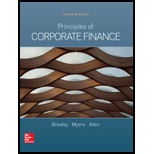
Principles of Corporate Finance
13th Edition
ISBN: 9781260465099
Author: BREALEY, Richard
Publisher: MCGRAW-HILL HIGHER EDUCATION
expand_more
expand_more
format_list_bulleted
Textbook Question
Chapter 20, Problem 18PS
Put–call parity There is another strategy involving calls and borrowing or lending that gives the same payoffs as the strategy described in Problem 6. What is the alternative strategy?
Expert Solution & Answer
Want to see the full answer?
Check out a sample textbook solution
Students have asked these similar questions
If a loan of $1,000 has 10% simple interest for 2 years, what is the interest?A) $100B) $200C) $150D) $250
Don't use chatgpt !!
A person invests $5,000 at 8% compound interest annually. What is the amount after 1 year?A) $5,800B) $5,400C) $5,600D) $5,000
Do not use chatgpt!!
What does ROI stand for in finance? A) Return on Investment B) Rate of Income C) Return on Interest D) Revenue on Investment
Chapter 20 Solutions
Principles of Corporate Finance
Ch. 20 - Vocabulary Complete the following passage: A _____...Ch. 20 - Option payoffs Note Figure 20.12 below. Match each...Ch. 20 - Option payoffs Look again at Figure 20.12. It...Ch. 20 - Option payoffs What is a call option worth at...Ch. 20 - Option payoffs The buyer of the call and the...Ch. 20 - Option combinations Suppose that you hold a share...Ch. 20 - Option combinations Dr. Livingstone 1. Presume...Ch. 20 - Option combinations Suppose you buy a one-year...Ch. 20 - Option combinations Suppose that Mr. Colleoni...Ch. 20 - Option combinations Option traders often refer to...
Ch. 20 - Prob. 11PSCh. 20 - Option combinations Discuss briefly the risks and...Ch. 20 - Put-call parity A European call and put option...Ch. 20 - Putcall parity a. If you cant sell a share short,...Ch. 20 - Putcall parity The common stock of Triangular File...Ch. 20 - Put-call parity What is put-call parity and why...Ch. 20 - Putcall parity There is another strategy involving...Ch. 20 - Putcall parity It is possible to buy three-month...Ch. 20 - Putcall parity In April 2017, Facebooks stock...Ch. 20 - Option bounds Pintails stock price is currently...Ch. 20 - Option values How does the price of a call option...Ch. 20 - Option values Respond to the following statements....Ch. 20 - Option values FX Bank has succeeded in hiring ace...Ch. 20 - Option values Is it more valuable to own an option...Ch. 20 - Option values Youve just completed a month-long...Ch. 20 - Option values Table 20.4 lists some prices of...Ch. 20 - Option bounds Problem 21 considered an arbitrage...Ch. 20 - Prob. 30PSCh. 20 - Prob. 31PSCh. 20 - Prob. 32PS
Knowledge Booster
Learn more about
Need a deep-dive on the concept behind this application? Look no further. Learn more about this topic, finance and related others by exploring similar questions and additional content below.Similar questions
- A person invests $5,000 at 8% compound interest annually. What is the amount after 1 year?A) $5,800B) $5,400C) $5,600D) $5,000arrow_forwardNo AI What does ROI stand for in finance? A) Return on Investment B) Rate of Income C) Return on Interest D) Revenue on Investmentarrow_forwardWhat does ROI stand for in finance?A) Return on InvestmentB) Rate of IncomeC) Return on InterestD) Revenue on Investmentarrow_forward
- A bank offers 6% annual interest. What is the interest on $500 for 1 year?A) $30B) $25C) $35D) $20arrow_forwardNo Ai A bank offers 2% interest per month. Annual rate is:A) 12%B) 18%C) 24%D) 20%arrow_forwardI need help! A bank offers 2% interest per month. Annual rate is:A) 12%B) 18%C) 24%D) 20%arrow_forward
- Don't use chatgpt! A bank offers 2% interest per month. Annual rate is:A) 12%B) 18%C) 24%D) 20% need help!arrow_forwardA bank offers 2% interest per month. Annual rate is:A) 12%B) 18%C) 24%D) 20%arrow_forwardDon't use chatgpt! A loan of $1,000 at 5% interest per year gives how much interest in 2 years? A) $50 B) $100 C) $75 D) $200arrow_forward
arrow_back_ios
SEE MORE QUESTIONS
arrow_forward_ios
Recommended textbooks for you
 Managerial Accounting: The Cornerstone of Busines...AccountingISBN:9781337115773Author:Maryanne M. Mowen, Don R. Hansen, Dan L. HeitgerPublisher:Cengage Learning
Managerial Accounting: The Cornerstone of Busines...AccountingISBN:9781337115773Author:Maryanne M. Mowen, Don R. Hansen, Dan L. HeitgerPublisher:Cengage Learning EBK CONTEMPORARY FINANCIAL MANAGEMENTFinanceISBN:9781337514835Author:MOYERPublisher:CENGAGE LEARNING - CONSIGNMENTPrinciples of Accounting Volume 2AccountingISBN:9781947172609Author:OpenStaxPublisher:OpenStax College
EBK CONTEMPORARY FINANCIAL MANAGEMENTFinanceISBN:9781337514835Author:MOYERPublisher:CENGAGE LEARNING - CONSIGNMENTPrinciples of Accounting Volume 2AccountingISBN:9781947172609Author:OpenStaxPublisher:OpenStax College Essentials of Business Analytics (MindTap Course ...StatisticsISBN:9781305627734Author:Jeffrey D. Camm, James J. Cochran, Michael J. Fry, Jeffrey W. Ohlmann, David R. AndersonPublisher:Cengage Learning
Essentials of Business Analytics (MindTap Course ...StatisticsISBN:9781305627734Author:Jeffrey D. Camm, James J. Cochran, Michael J. Fry, Jeffrey W. Ohlmann, David R. AndersonPublisher:Cengage Learning

Managerial Accounting: The Cornerstone of Busines...
Accounting
ISBN:9781337115773
Author:Maryanne M. Mowen, Don R. Hansen, Dan L. Heitger
Publisher:Cengage Learning

EBK CONTEMPORARY FINANCIAL MANAGEMENT
Finance
ISBN:9781337514835
Author:MOYER
Publisher:CENGAGE LEARNING - CONSIGNMENT

Principles of Accounting Volume 2
Accounting
ISBN:9781947172609
Author:OpenStax
Publisher:OpenStax College

Essentials of Business Analytics (MindTap Course ...
Statistics
ISBN:9781305627734
Author:Jeffrey D. Camm, James J. Cochran, Michael J. Fry, Jeffrey W. Ohlmann, David R. Anderson
Publisher:Cengage Learning

The Exchange Rate and the Foreign Exchange Market [AP Macroeconomics Explained]; Author: Heimler's History;https://www.youtube.com/watch?v=JsKLBpy6cEc;License: Standard Youtube License